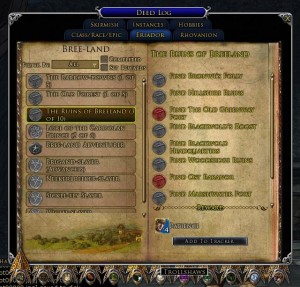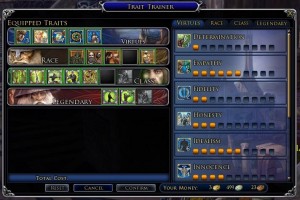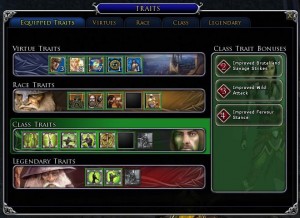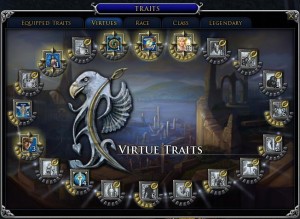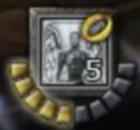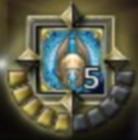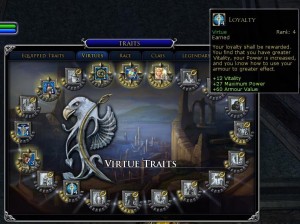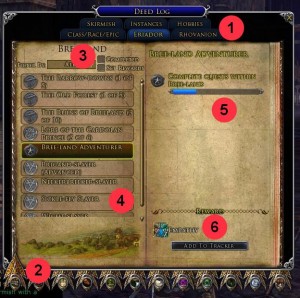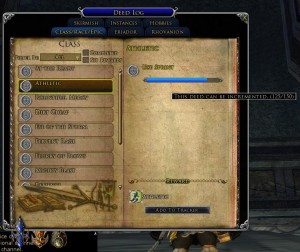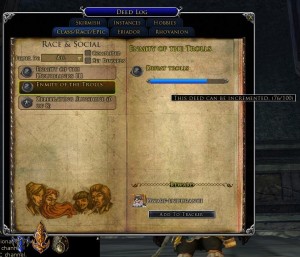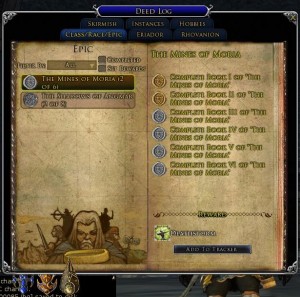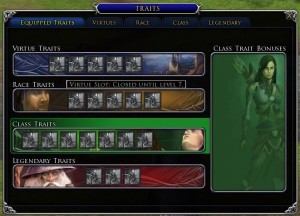This is the third post in a series of articles about the Trait system in the online roleplaying game, Lord of the Rings Online. You can see all the posts in this series by checking the Articles page, under ‘Virtues, Traits and Deeds (Lord of the Rings Online)’ (this link should take you to the V’s).
Update: This article was updated on 2nd January 2010 to correct the section on the Virtue Dialog.
Introduction
The first type of Trait you’re likely to earn in the Lord of the Rings Online is a Virtue. For the most part they are given as rewards to Deeds, although it’s possible to obtain them in other ways as well. Virtues carry the names of good qualities such as Charity, Valour and Justice. In this article I do not intend to list all the Virtues and their benefits, there are much better resources out there which do that. I really just want to provide an overview on what they are, where you get them and how you use them.
Benefits
All Virtues provide three different benefits and each specific benefit is also provided by three different Virtues, but the amount of benefit given varies. For a particular benefit, one Virtue provides the most benefit, a second Virtue provides a middle-amount and the third Virtue provides the least amount. Here’s a concrete example using the Justice, Determination and Tolerance Virtues.
- Justice provides increases to in-combat morale regeneration, base morale and out-of-combat morale regeneration. The primary benefit of Justice is in-combat morale regeneration (+6 per rank). No other Virtue provides this much increase per rank.
- Determination provides increases to agility, in-combat morale regeneration and base morale. The primary benefit of Determination is agility (+3 per rank), and in-combat morale regeneration is a secondary benefit (+4.5 per rank).
- Tolerance gives increases to tactical damage mitigation (primary), agility (secondary) and in-combat morale regeneration (tertiary benefit). The agility increase is less than Determination (at +2 per rank) and the in-combat morale regeneration is less than both Justice and Determination (at +3 per rank).
So, for any particular benefit which interests you, there will be three different Virtues which provide it. However, they provide it in decreasing value. One Virtue has it as a primary benefit, giving you the greatest increase, another has it as a secondary benefit and a third Virtue has it as a tertiary benefit. This system allows for a reasonably complex set of interactions and dependencies.
Gaining Virtues
As mentioned previously, for the most part Virtues are obtained by completing deeds. These are usually location based enemy kill deeds, but also include quest line completion deeds and location discovery deeds. Deeds usually provide a single rank increase to the Virtue although there are a small number of deeds which give 2 Virtue ranks.
If you do not have one of the Virtue traits, then completing any deed which provides any number of ranks gives you the new Trait (which you may then equip via a Bard). If you already have the Virtue at any rank, then any deed which gives that Virtue increases the rank appropriately (up to a maximum rank of 10, at the time of writing).
The reward section of the deed dialog shows which Virtue will be affected, and what rank it will be increased to. It does not show the number of ranks you will get in addition to those you already have, but the final rank you will be at if you get the reward. For example, the image below shows that on completing the deed listed (The Ruins of Breeland), the Patience Virtue will increase to rank 4.
If another deed is completed before this one which also increases Patience, the reward would change to show the rank as 5.
It does not matter what level your character is, and what level the enemies or location you’re fighting in is. If you’re level 65 and you do a deed in Breelands which gives you +1 to Tolerance for killing 40 spiders, you’ll get the increase. There are more ways of earning Virtue ranks than there are ranks of a Virtue so you’ll have some choice if you want to max your Virtues out.
Characters can earn Virtues as soon as they can start completing deeds which provide them (realistically, this will be around level 6-8), but they may not equip their first Virtue until level 7. Subsequent Virtue Trait slots open up at levels 9, 11, 17 and 23.
Equipping Virtues
Virtues are equipped by visiting a Bard, and using the first tab in the Trait management dialog (shown below) which lists all the Virtues you have earned and what rank they currently are (shown as orange squares).
As you can see, you can have five Virtues equipped at most at any one time. That’s a pretty small number considering there are 20 different Virtues in the game (and hence, 20 different benefits that can be obtained). Virtues are probably the traits that get swapped around the most (especially those that give increases to different types of damage resistance). Changing a Virtue Trait is reasonably inexpensive compared to other Traits.
Viewing Virtues
You can look at your current Virtues using the Trait window in two ways. The first tab shows your equipped Virtues and we’ve seen this dialog before. Hovering the mouse over a Trait icon shows you the benefits provided by that Trait.
If you click the Virtues tab of the Trait dialog you get a wheel-like layout, showing the 20 Virtues in the game, your current rank (if any) in each of them. It looks like this.
There are four different icon styles in the Virtue dialog, and they each mean something different, allowing you to see what state of progression each of your character’s Virtues are.
Hovering the mouse over an icon lists the benefits, as shown below for the Loyalty Virtue.
Summary
Virtues are the trait your character will start earning earliest. There are 20 Virtues, and they provide benefits to 20 different character attributes. Each benefit is improved by three different Virtues, and all Virtues provide three different benefits. They are cheap to switch around, and progressing them all to rank 10 will keep you busy long past the point where you reach the current level cap in-game.
For a full list of the benefits of Virtues, check out this page at the Lotro-Wiki site, and for an extremely useful resource for working out how to get the Virtues you want, check out the Virtues page at BurgZerg.

